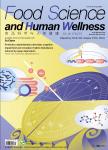Rational protein engineering of thermostable heparinase I from Bacteroides thetaiotaomicron for highly efficient heparin degradation
作者机构:State Key Laboratory of Food Science and Technology, Jiangnan University School of Food Science and Technology, Jiangnan University Key Laboratory of Industrial Fermentation Microbiology of the Ministry of Education & Tianjin Key Lab of Industrial Microbiology, College of Biotechnology, Tianjin University of Science and Technology National Engineering Research Center for Functional Food, Jiangnan University
出 版 物:《Food Science and Human Wellness》 (食品科学与人类健康(英文))
年 卷 期:2024年
核心收录:
学科分类:08[工学] 082203[工学-发酵工程] 0822[工学-轻工技术与工程]
基 金:supported by the Natural Science Foundation of Jiangsu Province (BE2021623 BK20220155) National Natural Science Foundation of China No. 32001665 U1903205 32021005 the National Key Research and Development Program of China grant number 2017YF0400303 the Key Scientific and Technological Research Projects in the Key Areas of the Xinjiang Production and Construction Corps 2018AB010 the Key Research and Development 303 Program of Ningxia grant number 2020BFG02012 Natural Science Foundation of Jiangsu Province (BE2021623) Collaborative innovation center of food safety and quality control in Jiangsu Province
摘 要:Heparin, a glycosaminoglycan, is a stable source of carbon that supports the growth of microorganisms in the human intestine. It is also a commonly used anticoagulant drug in clinical practice, with significant therapeutic effects. Low molecular weight heparin (LMWH) is a highly active low molecular weight fragment obtained via enzymatic reaction or the chemical degradation of heparin. LMWH has been applied globally in the prevention and treatment of venous thromboembolism in thrombosis patients. Simultaneously, as a potential prebiotic, because of its low molecular weight, LMWH can be well degraded by the gut microbiota to maintain intestinal balance. Enzymatic heparin degradation has recently emerged as a viable disposal method for LMWH preparation; however, only very few benchmark enzymes have been thoroughly described and subjected to protein engineering to improve their properties over the past few years. The commercialization of enzymes will require the development of robustly engineered enzymes that meet the demands of industrial processes. Herein, we report a rational protein engineering strategy that includes molecular dynamic simulations of flexible amino acid mutations and disulfide bond screening. Several Bt-HepI mutants were obtained and screened for high thermal stability. We obtained the Bt-HepID204C/K208C/H189W/Q198Rvariant, which features a stabilized protein surface structure, with a 1.3-fold increase in kcat/Km, a 2.44-fold increase in thermal stability at 50℃, and a 1.8-fold decrease in the average molecular weight of LMWH produced at 40℃ compared with that seen with Bt-HepIWT. Our study establishes a strategy to engineer thermostable HepI to underpin its industrial applications.



